Hardware Connections
Spacemap Go Help
Both Ethernet network and audio signal connections are necessary to create an operational Spacemap Go system. The Ethernet connections are for system control, Milan AVB audio transport between processors, and optional Milan AVB inputs. Analog and AES3 audio signal inputs are connected to the Galileo GALAXY processor(s). The processor outputs are connected to loudspeakers or other audio devices. The Spacemap Go app is used to configure the inputs and outputs of the system.
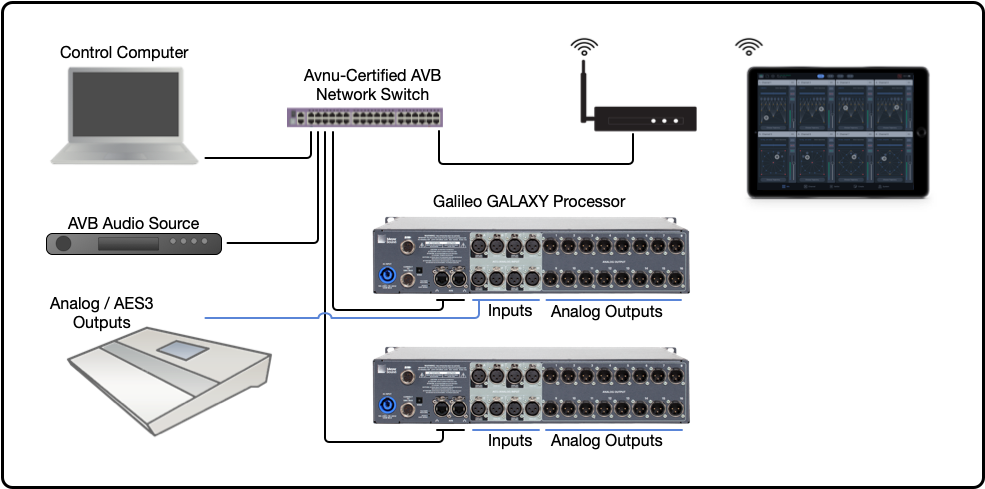
Example Ethernet and Audio Connections
Audio Input/Output Configurations
Source audio signals are connected to the Galileo GALAXY processor XLR inputs or via the RJ-45 connectors for Milan AVB audio streams.
Galileo GALAXY Audio Inputs
The iPad app Spacemap Go includes a connection wizard that configures the inputs and outputs of the GALAXY processors. For systems that include multiple processors, the wizard also configures the Milan AVB transport used to share input signals across the system processors. The configuration wizard assumes the first input is connected to input A and that additional inputs are contiguous.
Analog: make connections starting with Input A, then Input B, C, D, E, and F
AES3: make connections starting with Input A, then Input C, E, and G
Milan AVB: Any processor input can be selected to receive a Milan AVB stream. Matrix Inputs 9–32 of the GALAXY 816 models and Matrix Inputs 5–32 of the GALAXY 408 model are only used for Milan AVB inputs.
The AVB input stream format GALAXY processors accept is: AAF-PCM 24-bit in 32 integer, 8-channels of 12 samples at 96kHz or 48kHz.
AVB inputs from devices that are not Milan certified, may establish stream connections and transport audio successfully. However, these connections may not:
- Successfully re-establish connection after power cycling equipment (persistent connection)
- May not support the Milan network redundancy schemes
- May not maintain clocking between devices
For these reasons, we do not recommend using AVB input sources that are not Milan certified for show critical applications. Certification guarantees functionality, as all certified devices are rigorously tested for inter-connectivity and reliability. We cannot ensure the functionality of non-certified devices and encourage users to contact those device manufacturers, inquire about their certification status and how to make stable, persistent AVB connections to GALAXY processors.
Please see the Galileo GALAXY User Guide for further information about inputs and outputs.
Galileo GALAXY Audio Outputs to Loudspeakers
Analog and AES3: The outputs of Galileo GALAXY processors are analog, except for the 816AES model (legacy), which has 16 AES3 output channels available on XLR connectors 1–8, with analog copies of Outputs 9–16 available on XLR connectors 9–16. The outputs are typically connected directly to self-powered loudspeakers.
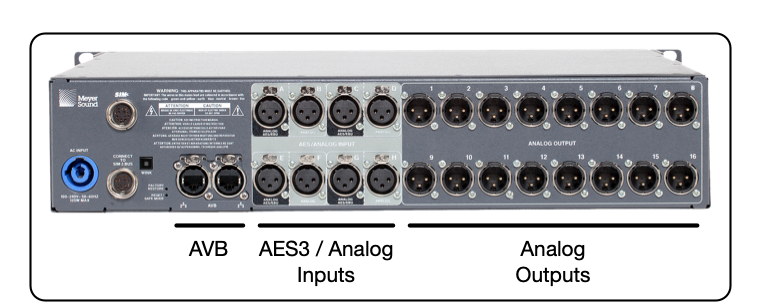
GALAXY 816 Audio Connections
Milan AVB: All GALAXY models have 16 outputs that are available as Milan AVB outputs. The output stream format is Milan compliant, AAF, 8-channel streams. Both 96 kHz and 48 kHz sample rate streams are available, Stream Output 0, 1, 4, and 5 below.
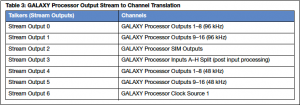
GALAXY Milan AVB Output Streams
Please see the Galileo GALAXY User Guide for further information about inputs and outputs.
Network Connections
Both the iPad and Galileo GALAXY processors must be connected to the same Ethernet network for control during system operation. iPad connections can be wireless. During processor configuration, a computer running Compass software is also connected to this network.
Ethernet
IPv6 is used for network connectivity between the Spacemap Go app on an iPad and GALAXY processors. Please ensure the wireless access point and the network switch are IPv6 enabled. The connection between a computer and a single Galileo GALAXY does not require a network switch.
Each GALAXY processor has two RJ-45 Ethernet connectors used for network connectivity and support a variety of redundant network schemes. Download the Galileo GALAXY User Guide for details.
When facing the rear of a processor, make primary network connections using Ethernet Port 1 (left connector) for standardization. Use Ethernet Port 2 (right connector) for connection to a redundant network. The ports are identical in function, sending and receiving different types of data. Compass, Compass GO, Spacemap Go, and devices that send and receive OSC commands are used to make changes to the processor settings. These ports also send and receive Milan AVB audio streams.
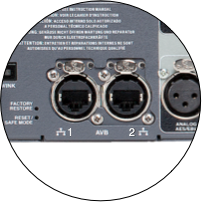 The two ports have different network speed capabilities:
The two ports have different network speed capabilities:
- Port 1 (left) is capable of both 1000bT and 100bT connections
- Port 2 (right) is 1000bT, or Gigabit Ethernet only
Devices capable of 100bT connections can only be connected to Port 1 for proper functionality. Many older or less functional network switches and access points (WiFi) are capable of only 100bT connections.
When using more than one GALAXY processor in a Spacemap Go system or when the system input source format is Milan AVB, an Avnu Alliance certified network switch is needed. Avnu-certified network switches are specialized switches, capable of supporting the underlying Milan AVB protocols and that have been certified for interoperability. Extreme network switch configuration instructions are available here. Generic network switches do not support Milan AVB audio streams but can be used for “control only” networks.
When GALAXY processors are booted into Spacemap Mode, the inputs of the processors are shared with the other processors over the Ethernet network using the Milan AVB protocol.
System Example One
Simplest system:
- Analog or AES3 audio inputs are connected to the GALAXY input XLR connectors.
- A wireless access point (WiFi) is connected to GALAXY Ethernet Port 1.
- An iPad running Spacemap Go is connected via wireless Ethernet (Wi-Fi) to the wireless access point.
- GALAXY processor analog XLR outputs are connected to loudspeakers (not shown below).
NOTE: An Avnu-certified network switch is not needed for this system because the network is not transporting any AVB streams. It is only used for control.

Example System – Analog/AES3 Inputs, Galileo GALAXY Processor, Wi-Fi Access Point, and an iPad (Loudspeakers Not Shown)
System Example Two
This example uses Milan AVB signal inputs and requires an Avnu Alliance certified AVB network switch. The source audio is sent via Milan AVB to the Galileo GALAXY.
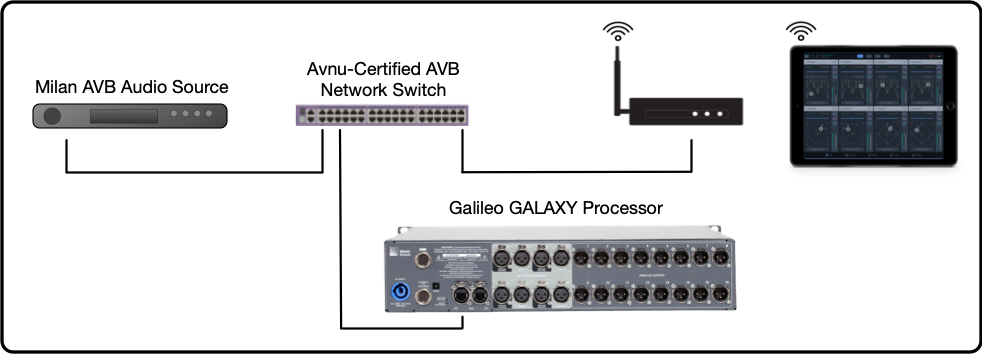
System Example Two: Milan AVB Audio Input and Analog Output
System Example Three
This example uses two GALAXY processors. The Milan AVB digital audio protocol is used to share the analog/AES3 inputs with the second processor. An Avnu Alliance certified network switch is needed. The GALAXY XLR outputs or the Milan AVB output streams can be used to connect to loudspeakers or other Milan AVB devices connected to the network switch.
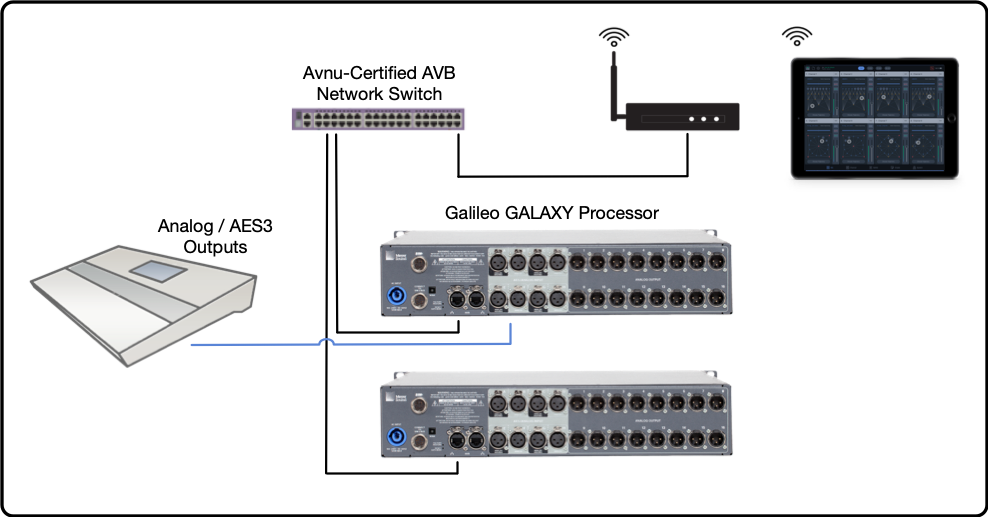
Example 3: Two Processors Used, Requires Avnu Certified Switch
AVB Milan Network Redundancy
A secondary/redundant network can be connected in case the primary network experiences an issue, which ensures continuous Milan AVB transport and system control connection.
AVB Clock Considerations
The connections of the AVB media clock will be automatically set when the Spacemap Go system configuration is completed.
What’s Next?
Please see Configure GALAXY Processors next.